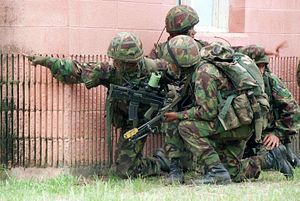The famed Gorkha Rifles, the renowned Nepalese warriors who formed an important part of imperial British and then modern Indian forces, were first formed two hundred years ago on April 24, 1815.
The origin of the Gurkha warriors in the British army dates back to the Anglo-Nepalese War of 1814-1816. At this time, the British East India Company (EIC) was expanding its territories in the subcontinent and had recently acquired what is today’s Uttar Pradesh, bringing it to the borders of the Gorkha or Nepali state. Nepal originated from the medieval Gorkha state in west-central Nepal. Prior to the 18th century, what is today’s Nepal was a patchwork of independent hill states, many of which were tributary to their larger neighbors in India or Tibet. In the wake of disintegration of the Mughal Empire, Prithvi Narayan Shah, king of Gorkha, conquered most of the Himalayan region of South Asia and began to expand outwards into the plains of northern India. The conquest of Kathmandu in the Newar or Nepal valley in 1768 gave the kingdom a new capital and eventually the Gorkha kingdom was named Nepal after the valley where its capital was located. Prior to this, the term Nepal only referred to a series of kingdoms in the Kathmandu valley.
Under future kings, an expanding Nepal came into conflict with this also-growing British and Sikh empires. In the west, in the modern Indian state of Himachal Pradesh, the Sikhs bested the Gorkhas at the giant fort of Kangra in 1809. Kangra was the main fort in the western Himalayan region of South Asia. Soon after, the British became concerned that there was no delineated boundary between their territories and the territories of their ally, the Nawab of Awadh (Oudh) and Nepal. This led the EIC Governor-General to declare war on the Gorkhas in 1814. The war ended well for the British in 1816, though they met stronger resistance than expected. This allowed Nepal to remain independent and resist incorporation into British India, either directly or as a princely state, though it remained largely under the sphere of British influence and a British residency was established in Kathmandu. The 1816 Treaty of Sugauli ceded some Nepali territory to the British. Much of this territory is part of the Indian states of Uttarakhand and Sikkim today.
Even while the war with the Gorkhas was going on, the British began recruiting soldiers from the hills, impressed by their tenacity and great skill in fighting in difficult terrain. They were also skilled with their special knife, the kukri. According to a British historian, the Gorkhas possessed many desirable military qualities:
They are tough, they are brave, they are durable, they are amenable to discipline. They have another quality which you could say some British regiments had in the past, but it’s doubtful that they have now, that is a strong family tradition. So that within each battalion there were usually very, very close family links, so when they were fighting, they were not so much fighting for their officers or the cause but for their friends and family.
The first Gorkha Rifles regiment was recruited in Uttarakhand by one Sir Robert Colquhuon on April 24, 1815 from soldiers from various Himalayan regions. Not all Gorkhas have to be from Nepal, technically. They can be from other hill regions in the Himalayas, and from other parts of India today, but most are from Nepal. Relations between Nepal and the British Raj were cordial after, especially since the Gorkha Rifles remained loyal to the British during the Indian Revolt (Sepoy Mutiny) of 1857, when many British Indian units mutinied.
From 1857 until 1947, the Gurkhas were an important and dependable part of the British Indian military. The British ruled most of their Asian and Middle Eastern colonies from India, not England, so the Gurkhas played an important role in Britain’s colonial wars, fighting in Burma, Afghanistan, China, and elsewhere. During World War I, 200,000 Gurkhas served, especially in the Middle East theater. Around 250,000 Gurkhas served in World War II, and helped protect India and fight Japanese forces in Burma and Singapore.
In 1947, with the independence of India, six Gorkha regiments joined the Indian Army while four continued to serve in the British Army, though these were amalgamated as the Royal Gurkha Rifles (RGR) in 1994. The six Indian units became seven, and the Indian Gorkha Rifles have fought for India against Pakistan and China. There are currently 30,000 Gorkhas serving in the Indian Army, serving under the motto “better to die than be a coward.”

































